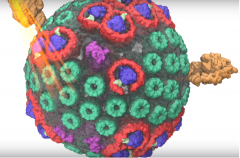ASU assistant professor studies how living cells capture, process and store energy

Abhishek Singharoy (right) and his graduate student Darren Thifault in the lab located in the new Biodesign C building. Photo by Mary Zhu/School of Molecular Sciences
The work of Abhishek Singharoy, assistant professor in Arizona State University's School of Molecular Sciences and member of the Biodesign Institute’s Center for Applied Structural Discovery, is featured in a recent article published by the Department of Energy on renewable biofuels.
Singharoy studies how living cells capture, process and store energy. In particular, he is interested in the ways that proteins can store and transform energy, something that most of them are not designed to do. Plants can do this as part of the photosynthetic pathway that transforms light into chemical potential energy. Higher organisms can do the same with nutrients.
“Proteins are not normally trained to sustain energy,” Singharoy said, but those of the purple bacterium are an exception. By “trained,” he means its proteins have evolved to cooperate to retain some of the solar energy they collect, converting it into adenosine triphosphate, an energy-storage molecule vital to all living organisms.
“These bio-energy proteins are very hot molecular targets” in drug design, Singharoy said. Malarial parasites, for example, share a protein with purple bacteria. A drug called atovaquone can prevent malaria by choking off that protein’s activity during mitochondrial respiration — the chemical steps in cells that make ATP from nutrients.
What makes Singharoy's investigations of these processes unique is that he can simulate these processes in ways that were unimaginable just a few years ago. Rather that study a protein in isolation, as is traditionally done, Singharoy studies proteins in proteins, and entire clockworks of proteins working together. These studies are performed using simulations on a massive scale, that take advantage of nanoscale molecular dynamics and visual molecular dynamics. These tools were originally developed under the leadership of Singharoy's research mentor Klaus Shulten, of the University of Illinois Urbana Champagne (UIUC). Together with colleagues at UIUC, Singharoy is developing these tools with the support of a major grant as part of the Department of Energy's INCITE (Innovative and Novel Computational Impact on Theory and Experiment) program, and 200 million processor hours on the Titan supercomputer at the Oak Ridge Leadership Computing Facility.

A frame from an animation of a chromophore’s light-absorption, charge separation, charge transport via the membrane, and adenosine triphosphate synthesis. Image courtesy of Abhishek Singharoy, Chris Maffeo, Karelia Delgardo, Melih Sener, Barry Isralewitz and John Stone
Singharoy and his colleagues have focused on the purple bacterium Rhodobacter sphaeroides to run the simulations. It’s an ideal model for computational and experimental companion studies of the design principles for photosynthesis or energy conversion in higher organisms’ cellular respiration. It also represents the first 100 million atom entire living object organelle that has been successfully simulated. Singharoy and his colleagues have been able to simulate the entire process of turning light energy into electrical energy, then into mechanical energy and finally into chemical energy and then onto work, in the purple bacterium’s chromatophore.
The results have been published in several papers over the last couple of years, including an overview article in the journal Elife, with lead author Melih Sener of UIUC, two papers in the Journal of the American Chemical Society and a 2018 paper in the Proceedings of the National Academy of Sciences.
Written by: Ian Gould, School of Molecular Sciences
More Science and technology

ASU receives 3 awards for research critical to national security
Three researchers in the Ira A. Fulton Schools of Engineering at Arizona State University have received grant awards under the …

Celebrating 34 years of space discovery with NASA
This year, NASA's Hubble Space Telescope (HST) is celebrating its 34th anniversary of the world's first space-based optical…

Making magic happen: Engineering and designing theme parks
The themed entertainment industry is widespread and diverse, encompassing everything from theme parks to aquariums, zoos, water…